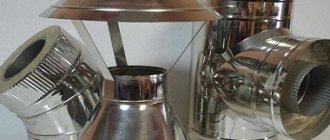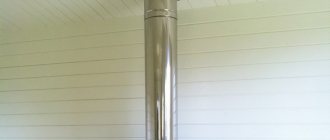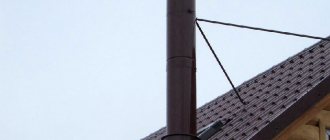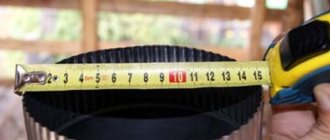If there is not enough draft, the operation of the stove will not be complete, anyone who has an idea about chimney pipes knows this.
In order to fully ensure normal draft, it is necessary that the air flow be sufficient and the gas outlet be carried out on time; for this, a deflector is needed on the chimney. Properly designed and high-quality smoke exhaust devices ensure the correct and trouble-free operation of any stove. The efficiency of the stove and ensuring normal draft is influenced by such factors as: changes in climatic conditions (wind, snowstorm, various types of precipitation), the presence of debris, which often falls directly into the chimney and clogs it.
To ensure the normal operation of a pipe in which there is no pressurization, a high-quality chimney is needed, which is able to ensure the timely and regular removal of combustion products. If the option under consideration is not possible for some reason, the presence of such a mechanism as a chimney deflector is an excellent assistant in this matter. Let's take a closer look at the topic - how to make a chimney deflector with your own hands: instructions and drawings.
What causes a chimney pipe to smoke?
A deflector is a device on a chimney pipe, the use of which creates obstacles in the path of air flow created by the wind. To put it simply, this is a very simple, but at the same time highly effective device for protecting the chimney from various types of litter, precipitation, etc.
Experts say that to increase the efficiency of the stove by 25%, it is enough to install a deflector on the smoke exhaust pipe. In order for it to work efficiently, correctly and without problems, it is necessary that the chimney itself be installed as expected (the required height of the structure, its location, the correct cross-section, etc.).
It often happens that the chimney pipe begins to smoke, and in order to eliminate this problem, you first need to find out what are the reasons for this behavior of the structure. So, the first reason is the increased speed and power of air flows due to strong, gusty winds. In this case, the smoke is simply “not allowed” to come out, crushing it with a strong flow entering the pipe.
The second reason is the incorrectly selected chimney diameter (the importance of this factor was previously mentioned). If the diameter is too small, the smoke will not have enough space to exit the pipe normally.
Smoke will be a regular process even if the chimney itself is not located correctly on the roof (as it turns out, even such seemingly insignificant details can affect the efficiency of the structure).
Rotary turbines for the exhaust system
These are the most popular devices for this purpose. Compared to other designs, their productivity is 20-25% higher.
The advantage of using them is that they do not use any energy source during operation.
Always rotating in one direction under the influence of the wind, the turbine head creates a vacuum inside the ventilation pipe, which promotes the active process of air circulation.
In addition, elegantly made of steel, it also serves the function of protecting the pipe mouth from atmospheric precipitation.
The head part is made of aluminum strips up to 0.5 millimeters thick, and the base is made of steel sheet painted in RAL colors.
Rotary turbines can be used on round, square or rectangular ducts or chimneys. In addition, they can be used for chimney systems.
Types of deflectors for the chimney pipe
After we have figured out the reasons, we can begin to solve the existing problem by analyzing the available types.
By design, there are several types of the device in question:
- “Volper” (has a fairly simple design and round shape)
- deflector for the Grigorovich chimney (looks like a gazebo)
- spherical (the name speaks for itself)
- N-type deflector
- "Shenard" (available in star shape)
- TsAGI
- Double
- "Deflector-Weather Vane"
Drawings, dimensions and parameters
Each of the available types has its own parameters and manufacturing methods. In order to understand the designs and parameters of such a device, we will consider several of them, and also find out how to make a chimney deflector with your own hands using drawings.
Deflector for the Grigorovich chimney pipe: this type is characterized by its simple design and high efficiency. The height of the device in question is 1.6 d, the width of the manufactured cap should not exceed 1.9 d. During manufacturing, it is also worth paying attention to the carefully selected width of the diffuser; in this case, the parameter in question will be equal to 1.3 d (it is also worth noting that the d value means the selected diameter of the chimney, or more precisely, its channel).
TsAGI deflector: in the form under consideration, the correctly selected size of the diffuser (more precisely, its wide part) plays an important role. This parameter is equal to 1.25 d, since it is necessary to make a ring here, you need to know its dimensions (height 1.3 d, diameter at this height should be equal to 2.5 d). Since this design contains a part in the form of an umbrella, its parameters must also be calculated accurately - the width of the part is 1.8 d.
Step-by-step instructions for making a weather vane
There are many options for making a chimney weather vane with your own hands. The drawings will help with this.
Original weather vane
A chimney deflector made of stainless steel and bronze for a more durable service.
The material for the manufacture of such a model will be stainless steel or copper, the thickness of which is 1 millimeter. Both of these metals have good anti-corrosion properties, they are lightweight and durable.
Advice! If copper is used, the service life of the weather vane increases, but it should be taken into account that this metal is more expensive.
The process of making a weather vane with your own hands:
Step 1. Select the mass and dimensions of the future model. Drawing will help
Calculation of the mass of the future weather vane based on the parameters of the pipe diameter, steel thickness, weight of the axle, bushing and bearings.
Step 2. Parts for the weather vane should be cut from the selected steel.
Using metal scissors, parts are cut out of stainless steel for the future weather vane-dome for the chimney
Step 3. We assemble the structure as shown in the figure.
The design of the weather vane and the schematic principle of assembly. Help for those who want to create it themselves
Step 4. The weather vane is ready.
The final version of the weather vane. Blue arrow - air intake, red smoke exit
Installation of such a weather vane is carried out on top of the chimney. It not only serves as decoration and gives the chimney duct a finishing look, but also prevents the occurrence of reverse draft.
Advice! Wind, temperature changes, and precipitation are factors that destroy the chimney pipe. Installing a weather vane is necessary to increase its service life.
Operating principle and design of the chimney deflector
Before you start making a deflector for a chimney with your own hands, you need, first of all, to know its structure, drawings and understand the principle of its operation. So, such devices, despite their multiple varieties, consist of three main parts: a diffuser, a cylinder and, directly, a cap. We should not forget about the seemingly insignificant, but in fact, important component of the deflector - ring-type rebounds.
Despite the variety of types of chimney deflectors, the principle of their operation is identical:
- The movement of air flows that enter the chimney is hindered by the walls of the cylinder, which is located in the upper part of the deflector. It turns out that the air flows hit it and a portion of the air mass from the jet moves up the cylinder itself, taking with it the smoke that comes out of the chimney.
- As a result, it turns out that the speed of smoke exiting the chimney becomes greater, while the draft increases significantly, which in turn increases the efficiency of the chimney itself.
- If there is a deflector, it does not matter at all what the speed of the air flow from the outside is, and from which direction the wind blows, because there are special gaps in the cylinder that suck the smoke into the air.
How to calculate the performance of a turbo deflector
Typically, a turbo deflector is simply placed at the outlet of a vent or chimney without any additional flow analysis, and the base value is used to calculate the performance of the turbo deflector. This value is indicated by the manufacturer in the labeling of the turbomachine; for example, the most popular model TD 400, according to its passport, has a capacity of 400 m3/h with a base wind speed of 2 m/s.
To calculate the required number of turbo deflectors, it is enough to take the required air exchange rate in the room and multiply the coefficient by the volume of the room. Next, the resulting value in cubic meters of air is divided by the basic performance of the turbo nozzle, and the number of devices is obtained.
Features of this design
If the wind blows from below, some turbulence is formed under the structure’s hood, which causes the smoke output to slow down (this is a minor, but still a drawback of the products in question). But here there is a way out, namely a solution to this problem - installing an inverted cone under the umbrella of the device itself.
Chimney deflectors are quite simple devices in design and operating principle, but at the same time, their efficiency can undoubtedly be called high. Each device, and deflectors are no exception, has certain disadvantages, but if we conduct a general analysis of all the available characteristics and capabilities of this device, then the pros and cons clearly have advantages over the cons and disadvantages.
Installation of a deflector on a chimney pipe
Correct manufacturing of such a design is not the key to the success of its operation, because installation, which is the final stage for using the device, plays an equally important role.
The deflector is installed on the chimney, and it will be easy to install both a self-made structure and one purchased in a store. Since the device consists of many parts, before climbing onto the roof and proceeding with installation, it must be assembled into a single whole. Making a deflector, the instructions and drawings of which will be discussed below, is quite simple to install, and in this case no additional skills and knowledge are needed.
The installation method will depend on the chimney pipe itself on which the deflector will be located. Most often, for a strong attachment it is enough to use a couple of drill holes and a clamp (you cannot do without drilling holes in the chimney itself). If the material with which the roof is covered is flammable, then you will have to additionally purchase a spark arrester, which must be installed on the deflector.
Gas duct options for a country house
To remove combustion products with a relatively low temperature (up to 120 ° C) emitted by gas boilers, the following types of chimneys are suitable:
- three-layer modular sandwich made of stainless steel with non-flammable insulation - basalt wool;
- a channel made of iron or asbestos-cement pipes, protected by thermal insulation;
- ceramic insulated systems such as Schiedel;
- a brick block with a stainless pipe insert, covered on the outside with heat-insulating material;
- the same, with an internal polymer sleeve of the FuranFlex type.
Three-layer sandwich device for smoke removal
Let us explain why it is impossible to build a traditional brick chimney or install an ordinary steel pipe connected to a gas boiler. The exhaust gases contain water vapor, which is a product of combustion of hydrocarbons. From contact with cold walls, moisture falls out as condensation, then events develop as follows:
- Thanks to numerous pores, water penetrates into the building material. In metal chimneys, condensate flows down the walls.
- Since gas and other high-efficiency boilers (using diesel fuel and liquefied propane) operate periodically, frost has time to capture moisture, turning it into ice.
- Ice granules, increasing in size, peel the brick from the inside and outside, gradually destroying the chimney.
- For the same reason, the walls of an uninsulated steel flue closer to the head are covered with ice. The passage diameter of the channel decreases.
Ordinary iron pipe insulated with non-flammable kaolin wool
Recommendations for selection
Since we initially undertook to install an inexpensive version of the chimney in a private house, suitable for DIY installation, we recommend using a stainless steel sandwich pipe. Installation of other types of pipes is associated with the following difficulties:
- Asbestos and thick-walled steel pipes are heavy, making work difficult. In addition, the outer part will have to be sheathed with insulation and sheet metal. The cost and duration of construction will definitely exceed the assembly of the sandwich.
- Ceramic chimneys for gas boilers are the best choice if the developer has the funds. Systems like Schiedel UNI are reliable and durable, but too expensive and out of reach for the average homeowner.
- Stainless steel and polymer inserts are used for reconstruction - lining of existing brick channels, previously built according to old projects. It is unprofitable and pointless to deliberately fence such a structure.
Flue option with ceramic insert
A turbocharged gas boiler can also be connected to a conventional vertical chimney, organizing the supply of outside air through a separate pipe. The technical solution should be implemented when a gas duct leading to the roof has already been installed in a private house. In other cases, a coaxial pipe is installed (shown in the photo) - this is the most economical and correct option.
The last, cheapest way to build a chimney deserves attention: make a sandwich for a gas boiler with your own hands. A stainless steel pipe is taken, wrapped in basalt wool of the required thickness and covered with galvanized roofing. The practical implementation of this solution is shown in the video:
Chimney of a solid fuel boiler
The operating mode of wood and coal heating units involves the release of hotter gases. The temperature of the combustion products reaches 200 °C or more, the smoke channel warms up completely and the condensate practically does not freeze. But it is replaced by another hidden enemy - soot settling on the inner walls. Periodically it ignites, causing the pipe to heat up to 400-600 degrees.
The following types of chimneys are suitable for solid fuel boilers:
- three-layer stainless steel (sandwich);
- single-wall pipe made of stainless or thick-walled (3 mm) black steel;
- ceramics.
A brick flue of rectangular cross-section 270 x 140 mm is lined with an oval stainless pipe
Asbestos pipes are contraindicated for installation on TT boilers, stoves and fireplaces - they crack from high temperatures. A simple brick channel will work, but due to roughness it will become clogged with soot, so it is better to line it with a stainless insert. The FuranFlex polymer sleeve will not work - the maximum operating temperature is only 250 °C.
Drawings on how to make a deflector for a chimney with your own hands
The sequence of actions during the manufacture of the device will be as follows:
- We make a drawing of all the parts on paper (and their hollow size), cut them out and connect them together.
- If all the parameters match on the paper model, we do the same on the metal sheet.
- A diffuser shape is cut out of a piece of metal and rolled into a cylinder.
- To connect all the parts of the deflector, you need to carefully drill holes in the elements and use bolts or special rivets to create a single structure.
- Then the cap is made, the strips are made, and all the separately made parts are joined together.
What is a chimney deflector video review
There is nothing complicated in the process of making a deflector for a pipe with your own hands, the main thing is to follow the assembly rules and do not forget about the correct selection of all design parameters.











